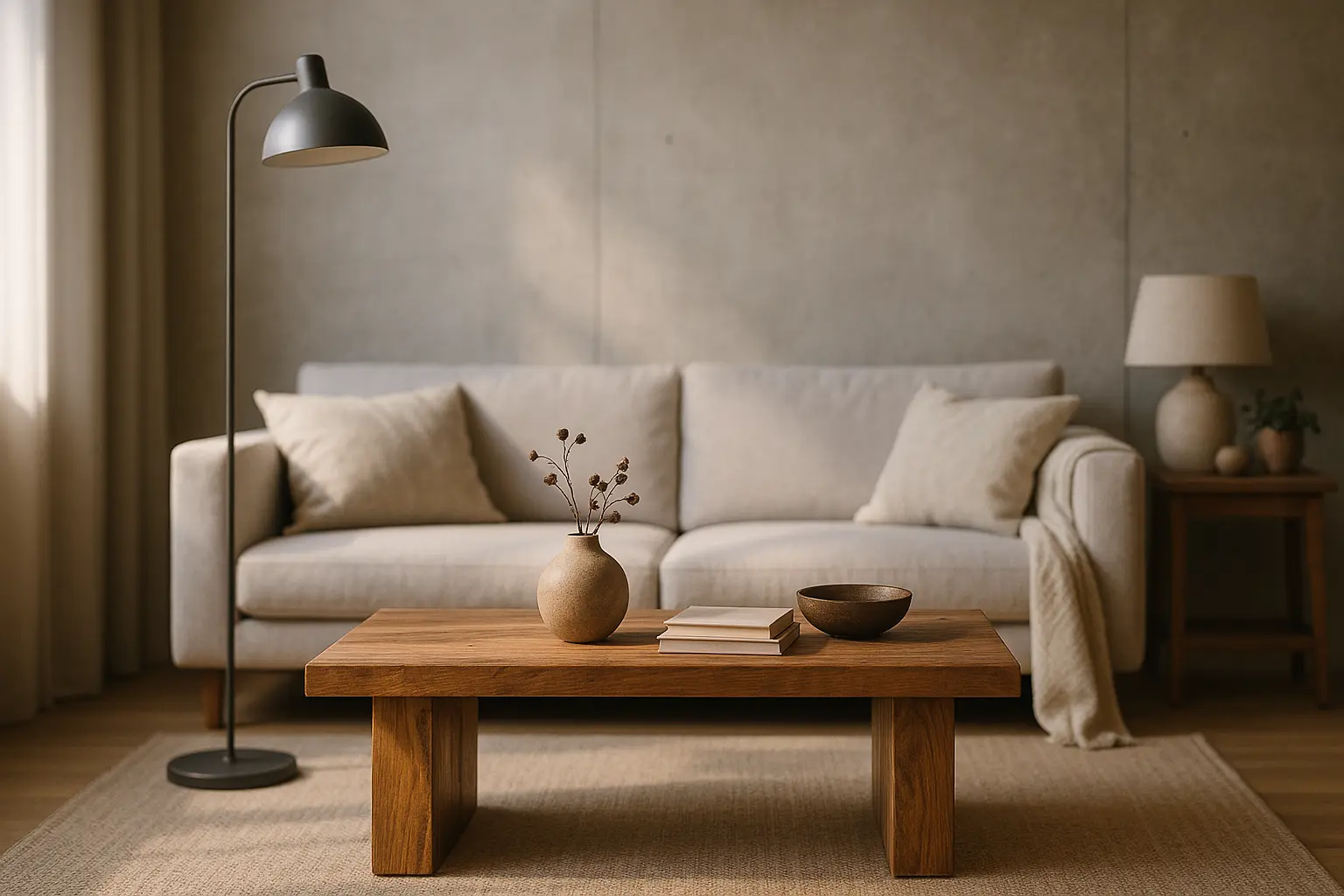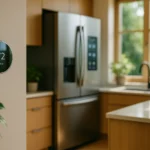In the landscape of modern interior design, where simplicity and natural textures speak volumes, raw materials have found a welcoming niche. Imagine stepping into a room where wood, steel, and concrete harmonize, creating an industrial haven that exudes both warmth and sophistication. These elements work in unison to transform ordinary spaces into extraordinary environments, extending an invitation to explore the boundaries of contemporary decor. Let me guide you through the transformative power of these natural textures, where each adds its unique flair to your home.
Embracing the Coziness of Wood
Wood has long been a staple in interior design, beloved for its timeless appeal and versatility. The allure of wood lies in its ability to introduce a sense of warmth and coziness to any space. From rustic beams in the living room to sleek cabinetry in the kitchen, wood finds its place in various forms, each contributing to a harmonious interior.
When designing with wood, consider the color and texture that best complements your style. Lighter woods, such as birch or pine, offer an airy ambiance, ideal for small rooms, whereas darker woods, like walnut or mahogany, evoke an elegant and grounded atmosphere. The grain of the wood adds character, with each knot and line telling a story of its origin.
Incorporating wooden furniture pieces, such as a reclaimed dining table or a mid-century coffee table, introduces a tactile experience that invites touch. Pair them with neutral decor elements like cushions or throws, allowing the wood’s natural beauty to shine. In more modern settings, sleek wooden panels can line the walls, adding depth and dimension without overwhelming the senses.
Wood’s ability to blend seamlessly with other materials makes it a favorite among designers. When mixed with steel or concrete, it offers a compelling contrast, where warmth meets industrial chic. This symbiotic relationship between elements crafts an environment that is not only visually stunning but also deeply connected to nature’s essence.
Industrial Elegance with Steel
Steel is the unsung hero of the industrial design movement, bringing a polished and modern edge to interiors. Its sleek lines and reflective surfaces offer a stark contrast to wood’s warmth, embodying a balance of strength and sophistication. In the realm of interior decoration, steel is not just a material; it’s a statement.
Incorporate steel in subtle yet impactful ways to accentuate your space. A sprawling steel-framed mirror can create the illusion of a larger room, while also bouncing light to create an ambient glow. Steel furniture, such as a contemporary coffee table or dining chairs, provides a minimalist touch, allowing other design elements to shine.
Steel’s versatility allows it to adapt to various styles, seamlessly integrating into both industrial lofts and sleek modern apartments. Its durability means that it can withstand the test of time, making it a wise investment for those looking for longevity in their design choices.
For those hesitant to fully commit to an industrial look, small accents like steel lamps or hardware can make a significant impact. These elements introduce a metallic edge without overwhelming the room. When combined with concrete or wood, steel helps create a layered effect that evokes both urban sophistication and organic warmth.
The Raw Power of Concrete
Concrete, often associated with urban landscapes, is a powerful material that has transcended its industrial roots to become a central player in interior design. Its raw, unrefined texture introduces an edgy contrast to softer elements, making it a popular choice for those seeking a bold and contemporary style.
In the world of interiors, concrete is more than a foundation; it’s a canvas. From countertops to accent walls, its adaptability allows it to morph into various forms, offering a stark yet serene backdrop for other decor elements. The minimalist appeal of concrete can transform a simple space into an architect’s dream, defined by clean lines and a muted palette.
To prevent a room from feeling too cold or sterile, pair concrete with warmer textures like wood or textiles. A plush rug or vibrant artwork can soften the industrial vibe, creating a balanced and inviting atmosphere.
Concrete’s strength lies in its ability to be both a background player and a featured star. Whether it’s a polished concrete floor that reflects natural light or a textured concrete wall that draws the eye, its understated elegance makes it a versatile choice for any home. When combined with steel and wood, concrete completes a triad of raw materials that embody modern sophistication.
Creating Contrast with Metal
When we think of metal in interior design, an image of cold and impersonal spaces might come to mind. However, metal can be a transformative element that adds depth and interest to any room. It acts as a bridge between other materials, offering a cool contrast that is both functional and stylish.
To incorporate metal into your decor, consider the various finishes available—brushed, polished, or matte—each offering a distinct texture and appeal. A brushed brass lamp can introduce a soft glow, while a polished stainless steel kitchen counter enhances a modern aesthetic.
Metal is a versatile material that can adapt to various design styles, from industrial lofts to cozy cottages. It pairs exceptionally well with wood and concrete, creating a dynamic interplay of textures. For example, a metal-framed bed against a concrete wall can create a bold focal point.
Using metal in smaller elements, such as picture frames or cabinet handles, can add subtle sophistication without overwhelming the space. Its reflective properties can also enhance lighting, making rooms feel larger and more open.
By integrating metal into your home, you can create a modern and cohesive look that respects the natural beauty of other materials. Through thoughtful design, metal becomes not just a supporting component but a key player in crafting a unique and harmonious environment.
The Art of Layering: Creating Depth with Raw Materials
Crafting a harmonious living space involves more than just selecting materials; it’s about creating a narrative through thoughtful layering. Combining wood, steel, and concrete requires a careful balance where each element plays a distinct role, contributing to an overall aesthetic that feels cohesive and inviting.
The key to successful design lies in understanding the inherent qualities of each material. Wood provides warmth, offering a tactile softness that invites touch. Steel introduces an urban edge, its coolness serving as a counterpoint to wood’s natural hues. Meanwhile, concrete anchors the space with its raw integrity, offering a canvas for creativity.
To create depth, begin with a neutral base—perhaps a concrete floor that sets the stage for other elements. Introduce layers of wood through furniture and accessories, allowing grain patterns to add visual interest. Finally, accent with steel, using it to frame windows or as a statement lighting fixture.
Decorating with raw materials is an opportunity to craft spaces that tell a story. It’s about embracing imperfections, celebrating textures, and blending contrasts to create a lived-in environment that resonates with authenticity. The art of layering transforms materials into experiences, where each room becomes a canvas, and every choice contributes to a narrative of modern elegance.
The journey through interior design with raw materials reveals a rich tapestry of possibilities. Wood, steel, and concrete each bring their distinctive voices, harmonizing to create interiors that are both inviting and sophisticated. By embracing these elements, we forge a connection to the natural world, crafting spaces that resonate with authenticity and modern elegance.
As we explore these materials, we discover their potential to transform any room into a reflection of our personal style. Whether through the warmth of wood, the sleekness of steel, or the raw power of concrete, we have the tools to design environments that speak to who we are. Let the dance of these materials guide your creative journey, and may your home be a testament to the beauty of nature’s gifts.
FAQ
What are the benefits of using raw materials like wood, steel, and concrete in home decor?
Incorporating raw materials such as wood, steel, and concrete into home decor can add a touch of natural beauty and industrial style. These materials are durable, versatile, and can create a modern yet timeless aesthetic. They also allow for a variety of textures and finishes that can enhance the visual appeal of any space.
How can wood be used effectively in interior design?
Wood can be used in numerous ways to enrich interior spaces. From flooring and wall paneling to furniture and decorative accessories, wood provides warmth and character. It can be left unfinished for a rustic look or polished for a more refined appearance. Wood’s versatility makes it suitable for both traditional and contemporary settings.
What are some creative ways to incorporate steel in home decor?
Steel can be introduced into home decor through elements like railings, furniture, light fixtures, and kitchen appliances. Its sleek and polished finish adds a modern touch, while its strength ensures durability. Steel can be used as an accent to highlight architectural features or as a focal point in minimalist designs.
How can concrete be integrated into home interiors without making the space feel cold?
To prevent concrete from feeling too cold or industrial, consider using it in combination with warmer materials such as wood or textiles. Concrete can be polished for a smooth finish or left rough for added texture. It’s great for flooring, countertops, and even decorative features like planters. Adding plants and soft furnishings can also help balance its starkness.
Are there any environmental considerations when using raw materials in decorating?
When using raw materials like wood, steel, and concrete, it’s crucial to consider their environmental impact. Opting for sustainably sourced wood, recycled steel, and eco-friendly concrete mixes can minimize environmental harm. Additionally, using these materials responsibly by incorporating them in ways that maximize longevity can contribute to more sustainable home decor practices.



